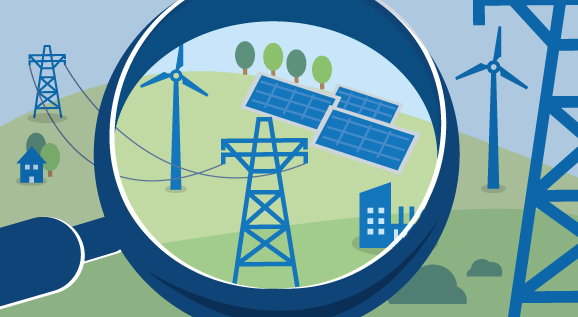What exactly is the plan approval procedure?
Gimme five! What happens in the fifth and final step in transmission grid planning, and who has a say in it? Read on to find out more.
 © BMWi
© BMWiGrid expansion planning involves five different steps. In the final step, the plan approval decision (building approval) is made, setting out all the important details for the new line, such as the exact route it will take.
The procedural steps in grid expansion planning – from the initial idea to the finished power line – can be counted on one hand. What sounds like child's play is, in practice, a complex procedure in which members of the public can have a say at any time.
In the planning process for expanding the grid, the first step is to forecast how the grid will need to look in ten or fifteen years by developing "scenario frameworks" to predict the future. The aim is to be able to ensure a reliable supply of electricity whilst carbon emissions decline and the share of renewable energy rises. The scenario frameworks form the basis for the creation of a Network Development Plan(step 2). This Plan documents the areas where the four operators of the large transmission grid (50Hertz, Amprion, TenneT and TransnetBW) see a need for conversion, expansion and modernisation measures to ensure that the electricity supply will remain secure in the future. The Bundesnetzagentur (Federal Network Agency) examines this assessment made by the transmission system operators.
Three steps to determine requirements, two steps for the approval
After the Network Development Plan is complete, the Federal Requirements Plan (step 3) sets out the starting and finishing points of the lines needed, but contains no specific information about the transmission route. This is not defined until the plan approval phase (step 5). Prior to this, however, is Federal Sectoral Planning (step 4), in which a route corridor is defined for the line is to run across. This corridor must be environmentally compatible and designed in line with the physical space available.
Growing anticipation as planning for the Bertikow-Pasewalk grid expansion project nears completion
The Bertikow-Pasewalk grid expansion project entered the plan approval procedure at the start of June 2019. With this fifth and final step now reached, anticipation surrounding construction is rising. In 2023, the new 32-kilometre-long line will go into operation along the existing route and connect the substations at Bertikow (Brandenburg) and Pasewalk (Mecklenburg-Western Pomerania). The line is needed as the output of renewable energy plants in Uckermark and Western Pomerania is set to increase significantly in the coming years. This means that the transmission capacity of the existing 220-kilovolt lines from the 1950s will no longer be sufficient to transport the wind power generated on land and at sea and power from conventional sources.
The plan approval procedure
So what happens in the fifth and final step before the grid expansion project? Let’s take the Bertikow-Pasewalk – project number 11 – as an example. The transmission grid operator involved in the project, 50Hertz, sends off its application for plan approval to the Bundesnetzagentur, in which it proposes to build the planned 380-kilovolt overhead line largely along the A 20 motorway. Applications always include alternative routes, an assessment of the effects on humans and nature, and detailed technology planning on how high the electricity masts should be and what they could look like. The Bundesnetzagentur publishes the application online. Its contents can then be discussed by all interested parties, in particular with members of the public, at a public "application conference". Those attending might, for example, provide specific information regarding parts of the proposed route.
Decisions made only following public participation
Based on the key points raised at the application conference, an "investigation framework" is developed. This contains requirements for the construction company to obtain further information as to where it might need to revise and/or supplement its proposal. These might be expert reports on protected animal species whose habitats are located within the planned route, or studies on other activities proposed. Once the proposal has been revised, it is re-published and discussed once again by all stakeholders so that nothing important is forgotten. Following this, the Bundesnetzagentur examines and decides what will ultimately be built, setting this out in the plan approval decision – a kind of building permit for the new power line.

